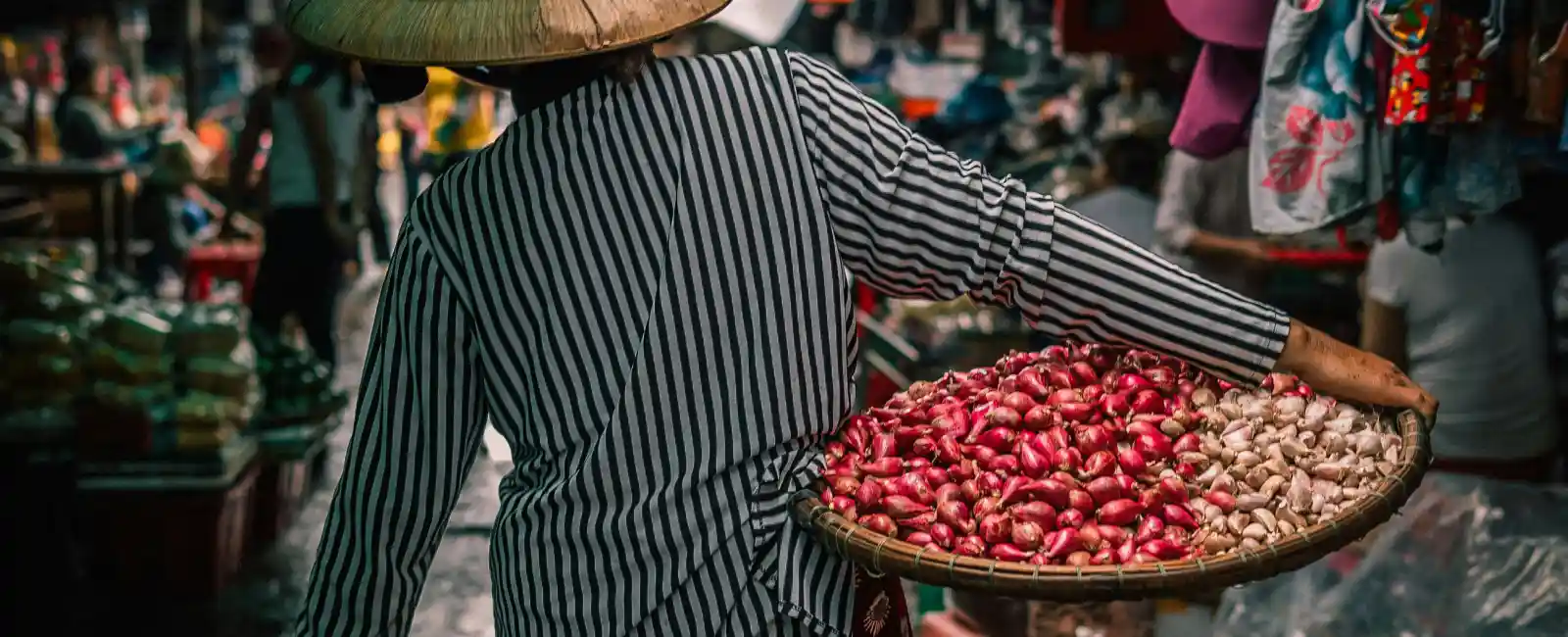Introduction to the Culinary Adventure
Traveling to Vietnam had always been a dream of mine. The thought of exploring vibrant markets, tasting authentic street food, and learning to cook like a local excited me. So, when I had the opportunity to join a food masterclass in Vietnam, I jumped at the chance. This experience would be more than just a cooking class; it would be a deep dive into the heart of Vietnamese cuisine.
Arriving in Hanoi: The Beginning of the Food Masterclass in Vietnam
Landing in Hanoi, the air was thick with the scent of herbs and spices. I scheduled my food masterclass in Vietnam for the next day, but I couldn’t resist exploring the local food scene right away.
As I strolled through the Old Quarter, I encountered countless food stalls. Each one offered something unique, from the famous pho to freshly rolled spring rolls. I indulged in a bowl of steaming pho, the broth rich and flavorful. The herbs were fresh, and the noodles were perfectly cooked. This was just a glimpse of what my food masterclass in Vietnam would offer.
The Day of the Food Masterclass in Vietnam
The next morning, I woke up early. After a quick shower, I quickly got ready, eager to dive into the culinary traditions that had drawn me halfway across the world.
With excitement building, I made my way to the class, which was set to take place in a traditional Vietnamese home, nestled in a quiet neighborhood away from the city’s usual hustle. The home was a beautiful mix of wood and stone, with intricate carvings adorning the entrance. Furthermore, lush green plants surrounded the courtyard, and the fragrance of blooming jasmine filled the air, adding to the authenticity of the experience.
Upon arriving at the entrance, I noticed Chef Lan awaiting us. Her warm smile instantly put everyone at ease. She was a petite woman, perhaps in her late fifties, with a gentle yet commanding presence.
Without delay, her deep knowledge of Vietnamese cuisine became apparent the moment she started talking about the day’s plan. “Vietnamese cooking is all about balance,” she explained, her voice melodic and soothing. “It’s about finding harmony between flavors, textures, and colors.”
Before we began cooking, Chef Lan insisted on taking us to the local market. “You cannot truly understand Vietnamese food unless you see where it begins,” she said with a knowing smile. The market was just a short walk from the house, and as we turned the corner, the lively scene unfolded before us.
This wasn’t just any market; instead, it was a bustling hub of activity, truly a sensory overload in the best possible way. As I wandered through, narrow paths brimmed with stalls, each overflowing with vibrant produce, fresh meats, and seafood seemingly just pulled from the ocean. Moreover, the mingling scents of herbs, ripe fruits, and the unmistakable aroma of street food filled the thick air, creating an unforgettable atmosphere.
Selecting products
As we walked through the market, Chef Lan led us to different stalls, stopping frequently to examine the produce. She pointed out the subtle differences between various types of rice, explaining how each one was suited to different dishes. “This is jasmine rice,” she said, holding up a handful of the fragrant grains. “It’s perfect for steaming, especially with fish or chicken.” Moving on, she introduced us to glutinous rice, which she explained was essential for making traditional desserts like sticky rice.
The importance of fresh herbs in Vietnamese cuisine was another key lesson. We paused at a stall overflowing with bundles of basil, mint, cilantro, and lemongrass. Chef Lan picked up a sprig of Thai basil, crushing it slightly between her fingers before holding it to our noses. The aroma was intense—peppery with a hint of sweetness. “Herbs are the soul of Vietnamese cooking,” she explained. “They add layers of flavor that transform a simple dish into something extraordinary.”
As we continued our tour, the seafood section caught my eye. The fish were laid out on beds of crushed ice, their scales shimmering under the morning light. There were prawns, crabs, clams, and more exotic varieties I couldn’t even name. Chef Lan explained how to select the freshest seafood, emphasizing the importance of clear eyes and a briny scent. “Freshness is everything,” she said. “It’s what makes our dishes so vibrant and alive.”
The food masterclass in Vietnam was already proving to be more than I had imagined. As we headed back to the house, I couldn’t wait to see how these fresh ingredients would come together under Chef Lan’s expert guidance. The adventure had truly begun.
Preparing Authentic Vietnamese Dishes: Hands-On Learning
After returning to the kitchen following our market visit, the atmosphere buzzed with anticipation. Since the food masterclass in Vietnam was designed to be immersive, our instructor, Chef Lan, made sure that we were involved in every step. The kitchen itself was a blend of traditional and modern elements, with all the necessary tools laid out, ranging from mortar and pestle to modern gas stoves. We were now about to embark on a culinary journey, crafting some of the most iconic dishes in Vietnamese cuisine: pho, banh xeo, and fresh spring rolls.
Mastering the Art of Pho: The Soul of Vietnamese Cuisine
The first dish we tackled was pho, a cornerstone of Vietnamese cuisine. To begin, the process started with the broth, which is the heart of pho. Chef Lan emphasized that the key to an authentic pho broth lies in the careful selection and preparation of ingredients. First, we roasted beef bones and onions over an open flame. This step was crucial because it added depth and a smoky richness to the broth.
Next, after roasting, we transferred the bones and onions to a large pot, adding water, star anise, cinnamon, and cloves. The simmering process was slow and deliberate, taking several hours to extract the full flavor from the bones. Importantly, we were instructed to periodically skim the surface to remove impurities, ensuring a clear and pure broth. Patience was essential here; otherwise, rushing this step could result in a bland or cloudy broth.
Meanwhile, as the broth simmered, Chef Lan demonstrated how to prepare the accompanying ingredients: thinly sliced beef, fresh herbs like basil and cilantro, and rice noodles. These components would be added to the broth at the final stage, creating a harmonious balance of flavors and textures. Throughout the process, Chef Lan provided tips on how to adjust seasoning to achieve the perfect balance of salty, sweet, sour, and umami.

Crafting Banh Xeo: The Art of the Vietnamese Pancake
Next, we moved on to banh xeo, a popular street food in Vietnam. Banh xeo translates to “sizzling cake,” named after the sound it makes when the batter hits the hot pan. The preparation of banh xeo began with the batter, made from rice flour, water, and turmeric. The turmeric not only gave the pancake its distinctive yellow color but also added a subtle earthy flavor.
Chef Lan demonstrated the technique of swirling the batter in a hot, oiled pan to create a thin, crispy layer. The challenge was to get the pancake crisp without burning it, requiring a balance between heat and timing. Once the batter was perfectly crisp, we added the fillings—shrimp, thin slices of pork, and bean sprouts. The key, as Chef Lan pointed out, was to cook the fillings just enough so that they retained their texture and flavor without overcooking.
After folding the pancake in half, we let it cook for a few more minutes, allowing the edges to crisp up further. Banh xeo is traditionally served with a side of lettuce and herbs. It is used to wrap pieces of the pancake before dipping them in a tangy nuoc cham sauce. The combination of the crispy pancake, savory filling, and fresh herbs was a perfect representation of Vietnamese cuisine.
Perfecting Fresh Spring Rolls: A Test of Precision
Our final dish of the day was fresh spring rolls, known as goi cuon in Vietnamese. These rolls are a staple in Vietnamese cuisine, celebrated for their freshness and simplicity. The preparation began with the soaking of rice paper, which required careful timing. The rice paper needed to be soft enough to roll without tearing but not so soft that it became sticky and difficult to handle.
The filling for the spring rolls consisted of cooked shrimp, vermicelli noodles, fresh mint, cilantro, and lettuce. We prepared each ingredient and laid them out in front of us. Chef Lan demonstrated the method of assembling the rolls. We placed the ingredients on the lower third of the rice paper, then rolled the paper tightly, folding in the sides to create the cylindrical shape.
Rolling the spring rolls required a delicate touch. Moreover, the challenge was to pack the ingredients tightly enough to hold together, without tearing the rice paper. Thankfully, Chef Lan guided us through the process, emphasizing the importance of even pressure and careful handling. As we practiced, our rolls gradually improved in appearance, becoming smoother and more uniform.
Finally, to finish, we prepared a dipping sauce made from hoisin, peanut butter, garlic, and chili. This sauce added a rich and flavorful contrast to the fresh and light rolls.
Savoring the Results: The Best Part of the Food Masterclass in Vietnam
After hours of preparation, it was time to enjoy the fruits of our labor. The food masterclass in Vietnam wasn’t just about cooking; it was also about savoring each dish. Sitting down at a communal table, we shared the meal we had prepared together.
The flavors were absolutely incredible. To start, the pho broth was rich and aromatic, with just the right balance of spices. Meanwhile, the banh xeo was crispy on the outside, yet soft and flavorful inside. Finally, the fresh spring rolls were light and refreshing, bursting with the flavors of fresh herbs and perfectly cooked shrimp.
The Cultural Insights Gained from the Food Masterclass in Vietnam
Beyond the cooking techniques, the food masterclass in Vietnam provided valuable cultural insights. Chef Lan shared stories about the history of Vietnamese cuisine. She explained how it was influenced by various cultures, including Chinese, French, and Thai. She also discussed the importance of food in Vietnamese culture, where meals are often a communal experience.
One of the most fascinating aspects of the food masterclass in Vietnam was learning about the symbolism of food. For example, people believe that the ingredients in pho represent different elements, creating a balance of flavors that mirrors the balance of life. Vietnamese culture and cuisine deeply embrace this concept of harmony and balance.
Taking the Experience Home: What I Learned from the Food Masterclass in Vietnam
The food masterclass in Vietnam was more than just a cooking lesson; it was an immersive cultural experience. I left with a deeper understanding of Vietnamese cuisine and culture, as well as a new set of skills that I could bring back home.
I found myself eager to recreate the dishes I had learned in my own kitchen. With this knowledge, I knew I could bring a piece of Vietnam back with me, no matter where I was.
Conclusion: Why a Food Masterclass in Vietnam is a Must-Do
If you’re passionate about food and culture, then a food masterclass in Vietnam is an experience you shouldn’t miss. Not only does it offer a unique opportunity to dive deep into the world of Vietnamese cuisine, but it also allows you to learn from experts who live and breathe the culinary traditions of their country.
By the end of the food masterclass in Vietnam, I realized that food is not just about taste; it’s a window into a culture, a way of life, and a source of endless discovery. This experience not only enriched my travels but also deepened my appreciation for the art of cooking. If you ever find yourself in Vietnam, don’t just eat the food—learn to cook it, understand it, and savor every moment of your culinary journey.



